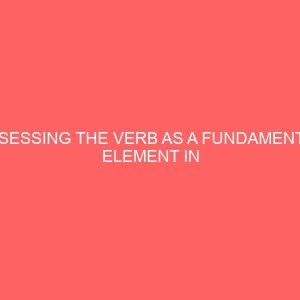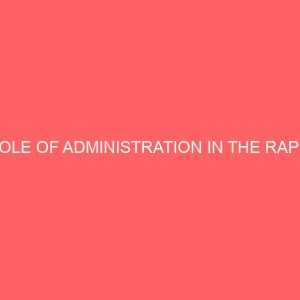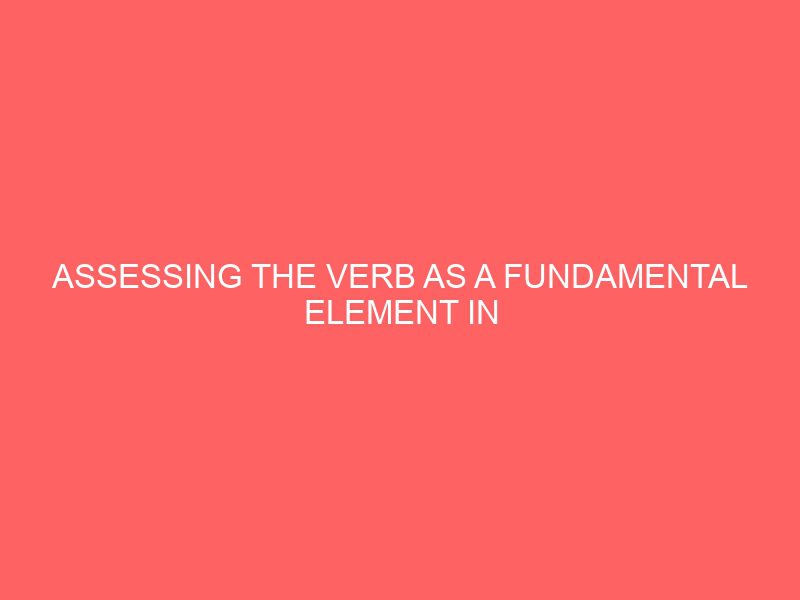Description
Abstract
This study assesses the verb as a fundamental element of English. Among the linguistic elements, the verb stands out not only as a ubiquitous, dynamic element, but as the most important of the syntactic elements. This superlative description of the verb is evident on its indispensability in projecting meanings in any expression.
Other elements, no doubt, contribute to complete expression, but none can stand alone and make complete utterance structurally and semantically. The verb as the heart and life of expressions expresses action/deed of the nominal, state of the nominal, events about the nominal, behaviours no other elements in their morphological changes can supersede. It is the fundamental nature of this unique element that this paper addresses in order to, recommend further research on the other elements to ascertain possibly, their essential contributions to sentence formation which might result in one or all these elements substituting the verb in its indispensability. In arriving at the unparalled functions of the verb, materials from the libraries and internet were examined. These sources provided the data which furnished the work with the fact needed in ascertaining the verb as an indispensable element for sentence completion, well formedness, semantic projection and category changing. This changing or functional shifting aids the noun and the adjective in taking care of situations incapable of being represented by these elements.
Table of Contents
Title Page i
Approval Page ii
Dedication iii
Acknowledgement iv
Table of Contents v
Abstract ix
Chapter One
1 Introduction
1.1 Background of the Study 1
1.2 Statement of the Problems 7
1.3 Purpose of the Study 7
1.4 Research Questions 8
1.5 Significance of the Study 8
1.6 The Scope of the Study 9
1.7 Research Methodology 9
1.8 Analysis of the Findings 9
1.9 Organizational Structure 10
II Literature Review 11
2.1 The Concept of Verb 11
2.2 Characteristics of Verbs 14
2.3 Categories/Classification of Verbs 15
2.3.1Finite Forms of Verbs 17
2.3.2Auxiliary Verbs 20
2.3.3NonFinite Forms of the Verb 21
2.4 Features of Verbs 23
2.4.1First Type 24
2.4.2Second Type 25
2.4.3Third Type 26
2.5 The Role of the Verb in the Formation of Meaningful Expressions 27
2.6 Summary 28
III The Roles of Other Syntactic Elements Visvis the English Verb 29
3.1 Introduction 29
3.2.1The Noun and the Verb Structural Relationship 29
3.2.2The Noun and the Verb Morphological Relation 31
3.2.3The Noun and the Verb Relationship of Complement 32
3.2.4The Noun and the Verb The Semantic Relationship 34
3.3.1The Verb and the Adjective Structural Relationship 35
3.3.2The Verb and the Adjective Complement Relationship 36
3.3.3The Semantic Relationship between the Verb and the Adjective 37
3.4.1The Verb and the Adverb Structural Relationship 38
3.4.2The Semantic Relationship between the Verb and the Adverb 40
3.5.1The Verb and the Prepositional Phrase Structural,
Complementary and Semantic Relationships 41
3.6 The Implications of these Relationships 42
3.7 Verbless Clauses 43
3.8 Conclusion 45
IV Analysis of the Findings 46
4.1 The Verb and Sentence Completion 46
4.2 The Verb and Wellformedness 47
4.3 The Verb and Illformedness 49
4.4 The Verb and Alternative Structures 51
4.5 The Verb and the Verbless Expressions 54
4.6 The Verb and Category Change 55
4.7 Summary 59
V Summary 60
5.1 Summary 60
5.2 Recommendations/Suggestions 63
Works Cited 65








Reviews
There are no reviews yet.